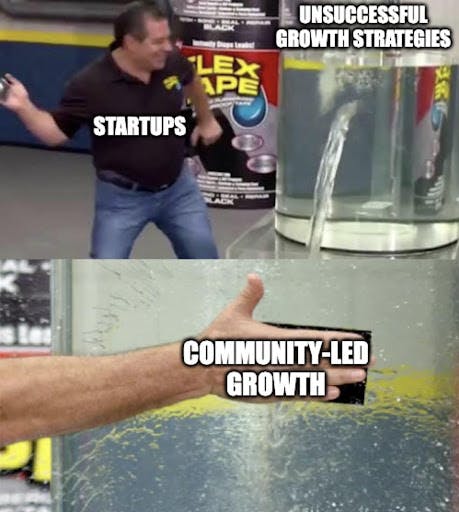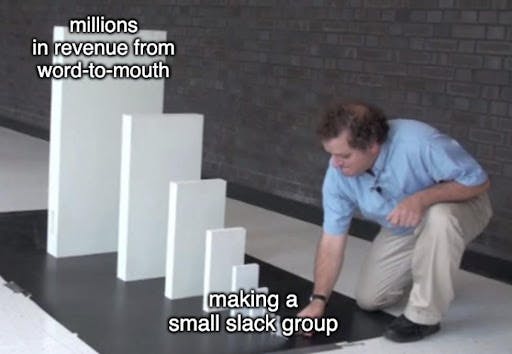The era of community-led growth

Don't mistake an audience for a community. Here are some tips on how to think about community building and why you would consider it.
Picture this—you’re in search of a new website builder for the side-project you’ve had on your vision board for years. There’s a small problem though…it’s 2022 and there are more tools out there than there are stars in the milky-way (or at least that’s what it feels like).
Soon, you realize that deciding on which tool to use is a to-do list item in itself. The paradox of choice overburdens you and now you’re turning to what every person eventually turns to— reviews. In the fit of what seems like one of the biggest decisions of your life, you come across a community for one of the tools.
You see authentic conversations about what others are doing and how they’re doing it. You come across people sharing projects that are eerily similar to what you planned. You see people from the company actively replying to customer queries and resolving requests as if the rent’s due. It’s a timeless haven of everything you’ll ever need from a service provider, all put together in one amazing place.
Now, you might feel drawn toward the product, but there's a catch. It’s less about the product itself and more about what comes with it. Ironically, what helps you decide on a product is something unrelated to what you were initially looking for.
You realize that you were not just looking for a product, but for an experience.
What’s community really about?
Until quite recently, “community” used to be just another buzzword attached to other aspects of a business (marketing, sales, support, etc.). Things changed and organizations gradually realized how fruitful community-led growth is on its own.
It won’t be long before more organizations realize that community- led growth is not about having an event twice a year and hoping to see conversions go through the roof. Community-led growth is about nurturing a space where people feel a sense of belonging.
- Pramod Rao, Co-founder, Threado
The last thing you should do is mistake an audience for a community. A group of people watching a movie at the theaters is not a community. Community is a space that reciprocates—it’s a place where people feel the most comfortable and where they can express themselves.
Thinking about this from a business perspective, the idea of building a community is to break down the barriers of communication and allow customers to interact with each other. Your only job as an organization is to facilitate that and move out the way.
The best part about community? It builds on the most fundamental aspect of human nature—our need for connection.
Community serves as a ripple effect— how you build it resonates with its members at such an intricate level that it inspires them to give back to the community and eventually contribute without expectations. When it comes to community, no one is the main character, and that’s the beauty of it.
Community before product
The power of community is still heavily underrated. Community-led growth is a GTM strategy that surpasses sales and even marketing-led strategies in many ways. When you start nurturing a community, you (intentionally or unintentionally) are finding product-market fit. In a way, building a prosperous community serves as proof that your product will be successful too.
Community-led growth can help establish your niche while initiating a movement that creates a relationship between your brand and the people who are a part of it. This relationship is way more robust than the one you can have with customers—people who are associated with your brand don’t only think of themselves as customers, but as members.
The idea of community isn’t anything new, but how companies are approaching it has tremendously changed in recent years. Community is becoming the center of attention and organizations are beginning to notice.
- Pramod Rao, Co-founder, Threado
So much happens as a by-product of community building:
- Building in public and getting valuable feedback can improve your organization’s roadmap altogether.
- Encouraging people to stir up conversations and share their gripes can help shape product-market fit.
- Networking and job opportunities. Connections today speak louder than resumes and communities catalyze that.
- Communities are built on many-to-many interactions that are value-first in nature. The value created drives word-of-mouth organically and this results in a growth flywheel for the community.
What not to do?
- Rely on community-building as a sales or marketing channel or expect instant ROI. Community-building takes time, so make sure you give it time.
Where to begin?
Just because community-led growth is shaping the future of business doesn’t mean you should mindlessly jump on the bandwagon.Community building is a painstaking process that takes time; it’s not a competition, it never was, and it never will be. If you’re building a community, you first need to ask yourself some very obvious, yet thought-provoking questions.
Why do I need a community?
This is a question that demands purpose. If you want to build a community, why do you want to do so? There’s no turning back. It’s not something you can forfeit after a few months— that’s not what community building is about.
Why would I join my community?
After you find the purpose, you need to validate it. Yes, you’re building a community, but why should people care? It’s important to look at it from an unbiased, third-person perspective. If you were a prospect, why would you join your community? The answer to this will help you find what sets your community apart.
What should I do differently?
A community is defined by its values and culture. Uniqueness is attractive and is also what binds people together. If you offer something people can’t get anywhere else, they’ll keep coming back.
After you’ve aligned your goals, defined strategies, and discovered your target audience, it’s time to start small. Community is a result of small and consistent wins that compound over time. Once you put in enough effort in the right places, you’ll reap the fruits of your labor
How can community be the answer you’re looking for?
Community members who are also customers have more than just the product to hold on to. They have a community and the longer they’re a part of it, the more likely they are to remain both loyal members and customers. These loyal members eventually become advocates of your product and/or brand, which in turn increases product visibility and retention.
If you’ve built your brand with your community in mind, the likelihood of cultivating more advocates is even greater. This is what makes community-led growth stand out. It might not be the fastest way towards growth, but it is the most sustainable.
Think of it as a flywheel - a self-sustaining process that spins on its own. The more friction there is, the sooner this flywheel model comes to a stop. You need to be responsible for reducing that friction, whether it’s a lack of engagement, poor onboarding, monotonous events, unclear purpose, or lack of strong community culture. Anything that can lead to friction in the flywheel must be weeded out.
Co-existence
Will community replace product-led growth? Which one is better? Which one should you go for? The truth is - community-led growth and product-led growth work best together— they can co-exist. Product-led growth has been instrumental to the success of many recently launched startups and their GTM strategies. It’s not even a question of whether it works, it’s more about how we can make it better.
While product-led growth can be what seamlessly guides customers through the product journey, community-led growth provides a platform for them to explore the product better. If anything, both of these growth strategies complement each other.
When done properly, community and product-led growth together have the potential for becoming the bible for the next generation of startups. There’s too much emphasis on “one or the other” but not enough on how well they complement each other.
- Pramod Rao, Co-founder, Threado

Community-led growth coupled with product-led growth can be an opportunity for accelerated growth. Not only does the user get a beautiful product experience, but they also get to interact with other users and delve deeper into the product’s utility together.
So, while your product may become a token of value in your customers’ lives, the community becomes a haven to discuss improvements, features, and bond with other loyal members.
Sharath Kuruganty is the Head of Community at Threado, a command center that helps community builders activate more members in their community by providing actionable insights and automating workflows. He is also a founder, community builder, and content creator.
Comments (23)
Dipika Gohil
Product Leader and no-coder
Ali Tanwir
Building a SaaS Startup
Jade Mackenzie
People & Culture for the Tech space
Cezary Dobrowolski
Dreamer counting his blessings.
Sinay Salomon
Product Manager at Vouch.
More stories

Aaron O'Leary · Announcements · 2 min read
Introducing Shoutouts

Finn Lobsien · Opinions · 5 min read
Can Devin AI Replace Product Managers?

Aaron O'Leary · News · 2 min read
Meet Nvidia's new localized AI chatbot

Sarah Wright · News · 2 min read
The top 15 AI products from 2023


